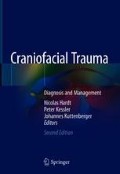Abstract
The reconstruction of craniofacial defects is a challenging task even for the experienced surgeon. For an optimal solution, the techniques and principles that have been described in the chapters before must be adapted to the individual situation. The challenges result from the patient’s individual situation, the preoperative planning efforts, from technical aspects as well as from the reconstructive means available. While the use of autografts has been the most widely recommended method, it does have its drawbacks, including long operation times, donor site morbidity, limited donor bone supply, as well as different anatomic and structural problems. The availability of autogenous bone grafts resembling the form of the skull is limited. Therefore, there is a need for alternative materials with adequate mechanical properties and biocompatibility (Blake et al. 1990; Eufinger et al. 1995; Eufinger and Wehmöller 1998, 2002; Klongnoi et al. 2006; Wiltfang et al. 2002, 2003; Schiller et al. 2004; Thorwarth et al. 2005; von Wilmowsky et al. 2008).
Access this chapter
Tax calculation will be finalised at checkout
Purchases are for personal use only
References
Balani K, Anderson R, Laha T, Andara M, Tercero J, Crumpler E, Agarwal A. Plasma-sprayed carbon nanotube reinforced hydroxyapatite coatings and their interaction with human osteoblasts in vitro. Biomaterials. 2007;28:618–24.
Blake GB, MacFarlane MR, Hinton JW. Titanium in reconstructive surgery of the skull and face. Br J Plast Surg. 1990;43:528–35.
Eufinger H, Wehmöller M. Individual prefabricated titanium implants in reconstructive craniofacial surgery: clinical and technical aspects os the first 22 cases. Plast Reconstr Surg. 1998;102:300–8.
Eufinger H, Wehmöller M. Microsurgical tissue transfer and individual computer-aided designed and manufactured prefabricated titanium implants for complex craniofacial reconstruction. Scand J Plast Reconstr Surg Hand Surg. 2002;36:326–31.
Eufinger H, Wehmöller M, Machtens E, Heuser L, Harders A, Kruse D. Reconstruction of craniofacial bone defects with individual alloplastic implants based on CAK/CAMmanipulated CT-data. J Craniomaxillofac Surg. 1995;23:175–81.
Hattar S, Asselin A, Greenspan D, Oboeuf M, Berdal A, Sautier JM. Potential of biomimetic surfaces to promote in vitro osteoblast-like cell differentiation. Biomaterials. 2005;26:839–48.
Hon KB, Gill TJ. Selective laser sintering of SiC/polyamide composites. CIRP Annals. 2003;52(1):173–6.
Hutmacher D, Sittinger M, Risbud M. Scaffold-based tissue engineering: Rationale form computer-aided design and solid free-form fabrication systems. Trends Biotechnol. 2004;22:354–62.
Jahur-Grodzinski J. Review—biomedical application of functional polymers. Reactive Funct Polym. 1999;39:99–138.
Klein CP, Patka P, Wolke JG, Blieck-Hogervorst JM, de Groot K. Long-term in vivo study of plasma-sprayed coatings on titanium alloys of tetracalcium phosphate, hydroxyapatite and a-tricalcium phosphate. Biomaterials. 1994;15:146–50.
Klongnoi B, Rupprecht S, Kessler P, Thorwarth M, Wiltfang J, Schlegel KA. Influence of platelet-rich plasma on a bioglass and autogenous bone in sinus augmentation. An explorative study. Clin Oral Implants Res. 2006;17:312–20.
Li LH, Kim HW, Lee SH, Kong YM, Kim HE. Biocompatibility of titanium implants modified by microarc oxidation and hydroxyapatite coating. J Biomed Mater Res A. 2005;73:48–54.
Poeck K. Neurologie. Berlin: Springer; 1987.
Poukens J, Laeven P, Beerens M, et al. A classification of cranial implants based on the degree of difficulty in computer design and manufacture. Int J Med Robotics Comput Assist Surg. 2008;4(1):46–50.
Rodil SE, Olivares R, Arzate H. In vitro cytotoxicity of amorphous carbon films. Biomed Mater Eng. 2005;15:101–12.
Schiller C, Rasche C, Wehmöller M, et al. Geometrically structured implants for cranial reconstruction made of biodegradable polyesters and calcium phosphate/calcium carbonate. Biomaterials. 2004;25:1239–47.
Thorwarth M, Schultze-Mosgau S, Kessler P, Wiltfang J, Schlegel KA. Bone regeneration in osseous defects using a resorbable nanoparticular hydroxyapatite. J Oral Maxillofac Surg. 2005;63:1626–33.
von Wilmowsky C, Vairaktaris E, Pohle D, Rechenwald T, Ltz R, Münstedt H, Koller G, Schmidt M, Neukam FW, Schlegel KA, Nkenke E. Effects of bioactive glass and beta-TCP containing three-dimensional laser sintered polyetheretherketone composites on osteoblasts in vitro. J Biomed Mater Res A. 2008;87A(4):896–902.
Wiltfang J, Merten HA, Schlegel KA, Schultze-Mosgau S, Kloss FR, Rupprecht S, Kessler P. Degradation characteristics of a- and tri-calcium-phosphate (TCP) in minipigs. J Biomed Mater Res. 2002;63:115–21.
Wiltfang J, Kessler P, Buchfelder M, et al. Reconstruction of skull bone defects using the hydroxyapatite cement with calvarial split transplants. J Oral Maxillofac Surg. 2003;62:29–35.
Zegers T, Ter Laak-Poort M, Koper D, Lethaus B, Kessler P. The therapeutic effect of patient-specific implants in cranioplasty. J Craniomaxillofac Surg. 2017;45:82–6.
Author information
Authors and Affiliations
Corresponding author
Editor information
Editors and Affiliations
Rights and permissions
Copyright information
© 2019 Springer International Publishing AG, part of Springer Nature
About this chapter
Cite this chapter
Kessler, P. (2019). A Treatment Algorithm in Craniofacial Reconstruction: Patient-Specific Implants. In: Hardt, N., Kessler, P., Kuttenberger, J. (eds) Craniofacial Trauma. Springer, Cham. https://doi.org/10.1007/978-3-319-77210-3_16
Download citation
DOI: https://doi.org/10.1007/978-3-319-77210-3_16
Published:
Publisher Name: Springer, Cham
Print ISBN: 978-3-319-77209-7
Online ISBN: 978-3-319-77210-3
eBook Packages: MedicineMedicine (R0)

